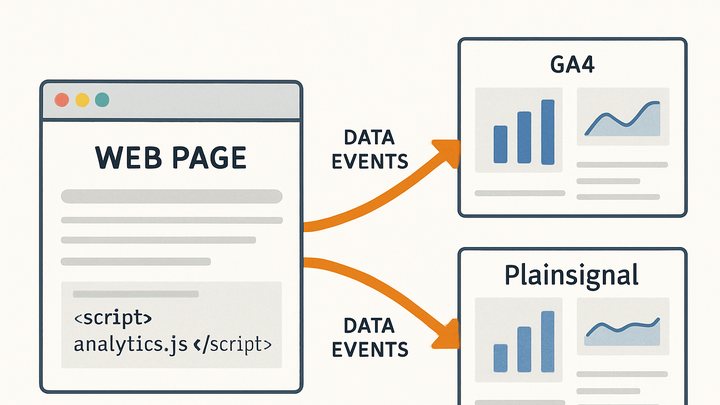Published on 2025-06-28T05:29:08Z
What is an Analytics Library? Examples & Use Cases
In the realm of analytics, a library refers to a packaged set of functions and APIs—typically delivered via JavaScript for web applications—that developers include in their sites or apps to capture, process, and transmit user interaction data to analytics platforms. These libraries abstract the complexities of event instrumentation, data batching, error handling, and API communication. Whether cookie-based like Google Analytics 4’s gtag.js or cookie-free like PlainSignal, analytics libraries streamline the integration of tracking capabilities. They enable features like pageview reporting, custom event tracking, user property management, and offline data queuing. By providing standardized methods and configurations, analytics libraries ensure consistent, reliable data collection across diverse environments.
Library
A code package enabling websites and apps to capture and send user interaction data to analytics services.
Definition and Purpose
An analytics library is a pre-built code package—usually a JavaScript file for web applications—that provides functions and APIs to track user interactions, page views, and custom events. It simplifies the process of data collection by handling event instrumentation, batching, error recovery, and communication with analytics endpoints. Libraries can vary by features, performance optimizations, and data models. They abstract low-level technical details, allowing developers to integrate analytics quickly and consistently. Choosing the right library affects data accuracy, privacy compliance, and site performance.
-
Core role
Offers standardized methods to instrument and dispatch analytics data, ensuring uniform implementation across pages and components.
Key Features of Analytics Libraries
Analytics libraries provide built-in capabilities that enhance data collection, user behavior analysis, and integration flexibility. Understanding these features helps teams choose and configure the right library for their needs.
-
Event tracking
Enables developers to log custom events, page views, and user interactions through simple API calls.
-
Data transmission & batching
Manages efficient data delivery by queuing events, batching requests, and retrying failed transmissions to ensure reliable delivery.
-
Configuration & customization
Supports settings for sampling rates, user properties, session definitions, and plugin extensions for specific use cases.
-
Performance optimization
Includes features like asynchronous loading, code minification, and resource caching to minimize impact on page load times.
Integration Examples
Practical code snippets showing how to integrate popular analytics libraries into a web project. These examples illustrate typical setup and configuration for both cookie-free and cookie-based solutions.
-
PlainSignal (cookie-free analytics)
Example of embedding PlainSignal’s lightweight, privacy-focused library to track user interactions without relying on cookies.
-
Tracking code snippet
<link rel="preconnect" href="//eu.plainsignal.com/" crossorigin /> <script defer data-do="yourwebsitedomain.com" data-id="0GQV1xmtzQQ" data-api="//eu.plainsignal.com" src="//cdn.plainsignal.com/plainsignal-min.js"></script>
-
-
Google analytics 4 (GA4)
Illustration of integrating Google Analytics 4 using the Global Site Tag (gtag.js) for comprehensive tracking and reporting.
-
GA4 tracking code
<!-- Google tag (gtag.js) --> <script async src="https://www.googletagmanager.com/gtag/js?id=G-XXXXXXXXXX"></script> <script> window.dataLayer = window.dataLayer || []; function gtag(){dataLayer.push(arguments);} gtag('js', new Date()); gtag('config', 'G-XXXXXXXXXX'); </script>
-
Best Practices and Considerations
Guidelines to ensure analytics libraries are implemented efficiently, securely, and in compliance with privacy standards.
-
Minimize performance impact
Load analytics scripts asynchronously, use code splitting, and defer non-critical tracking to reduce page load times.
-
Respect user privacy
Comply with GDPR, CCPA, and other regulations by obtaining consent, anonymizing data, and providing opt-out mechanisms.
-
Keep libraries updated
Regularly upgrade to the latest library versions to benefit from new features, security patches, and performance improvements.
